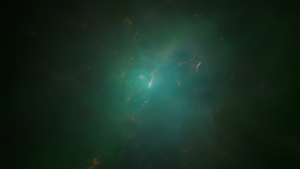Blog
Brightly Burning Galaxies
25 September 2015
 Robert Thompson (NCSA)
Robert Thompson (NCSA)A candle that burns twice as bright burns half as long, so the saying goes. We’ve thought of galaxies in the same way, in that the brightest galaxies (ones with high rates of star production) are likely in a cosmologically brief period of high activity. But new computer models suggest that might not be the case.1
Typically the brightest galaxies are ones that have undergone a collision with another galaxy. When two galaxies collide, the gas and dust in those galaxies interact, triggering the production of new stars. This causes the galaxy to brighten, but typically only lasts about 100 million years, which is fairly short on the cosmic scale. But what about the brightest galaxies in the early universe?
These early bright galaxies aren’t bright in the visible spectrum because of their high redshift. Instead they are brightest at wavelengths below a millimeter. For this reason they are known as submillimeter galaxies. They are typically quite large, with masses of about 100 Milky Ways, and are producing stars at a rate of about 1,000 per year. This is far more active than more modern bright galaxies. One could imagine that, like modern galaxies, their intense star production is short lived. But computer simulations of these monstrous galaxies found something interesting.
Rather than producing stars in a rapid flurry, the model galaxies produced stars over a period of a billion years. In a region of rapid star production cold gas and dust surrounding the region is pushed outward by the radiant pressure of the region. Once star production slows, the surrounding gas and dust collapses inward again, producing a new round of star production. This ebb and flow of gas and dust allows for a steady production of new stars. The team also found that these large galaxies could fragment into clusters of smaller galaxies, which would imply that submillimeter galaxies are the precursors to the large superclusters of galaxies we observe more locally.
So perhaps submillimeter galaxies are like galactic nurseries, producing clusters of galaxies similar to the way stellar nurseries produce clusters of stars.
Narayanan, Desika, et al. “The formation of submillimetre-bright galaxies from gas infall over a billion years.” Nature 525.7570 (2015): 496-499. ↩︎